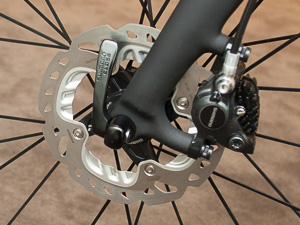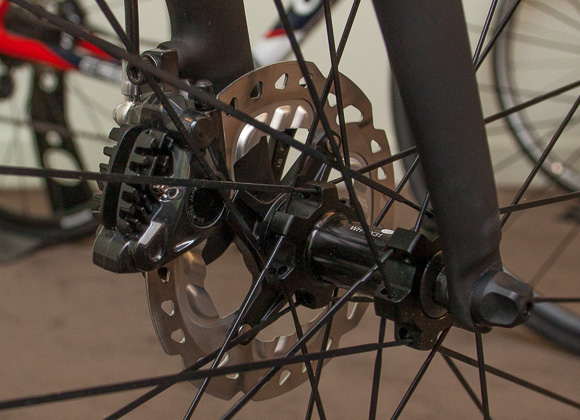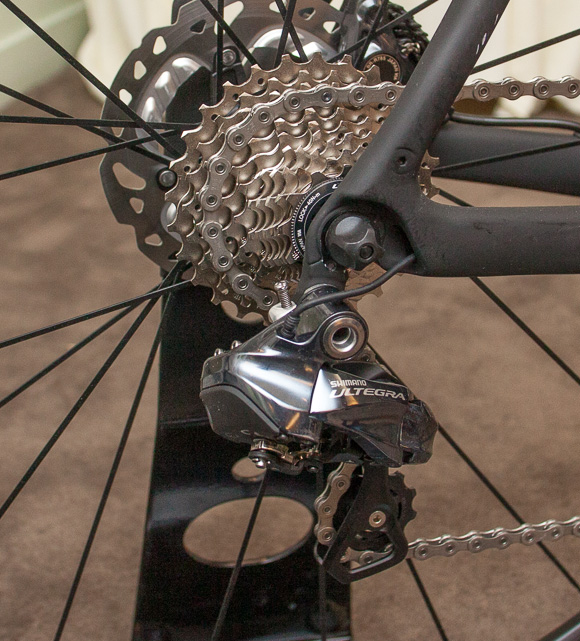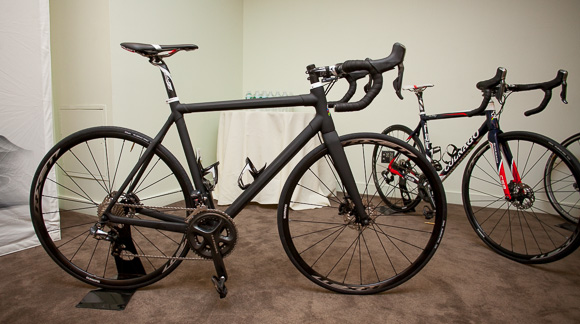
Disc brakes for road bikes might be a controversial topic but a short ride on Shimano’s new R785 disc brake group has reinforced my belief that it’s inevitable (Sram recall notwithstanding). The variable is if the industry goes quickly and willingly or kicking and screaming. The group is being competition tested now in cyclocross by Nys, Albert, and Walsleben.

Here’s the lever. This is a Di2-only group – there’s no shift mechanism inside the hood, so it can stay relatively svelte despite housing the reservoir. It’s not the prettiest lever ever, or even the second prettiest, but the ergonomics are spot on.

You tend to brake longer and more consistently on the road than mtb or cx, so cooling is critical. The rotor is a steel-aluminum-steel sandwich that takes advantage of aluminum’s superior heat conductivity (just like All Clad cookware!). More aluminum extends toward the hub with a scalloped profile to increase surface area. The pad holders also have aluminum fins to dissipate heat. This technology is carried over from Shimano’s downhill Saint components. Total heat reduction is claimed to be 200 degrees. These are dual piston calipers that, if properly set up, don’t drag on the rotors at all.

The four arm spider for the rotor is unique to the road group. 140mm rotors are standard for front and rear and provide more than enough stopping power, with no rider weight limit. The hose for the hydraulics is a little less stiff than its mtb counterpart. Its ability to expand in volume slightly gives the system more modulation – kinda like how brake cable housing compresses a little.
A non metallic resin pad comes standard for the group. It’s supposed to be less prone to squealing though less long lasting. On my test ride it was perfectly silent, and so smooth there was no sensation of a rotor grinding past brake pads (it’s not impervious to squeals if you get it dirty, however). The smoothness is slightly eerie and totally awesome. The smooth and quiet operation gives you confidence to carry more speed and brake later and later.

Ultegra Di2 gets a nice upgrade. Both derailleurs are slimmer, with new motors and graphics. The rear derailleur has a couple of cage options so you can run crazy wide cassettes like an 11-32. This is an Ultegra group but it’s compatible with Dura Ace Di2 derailleurs and XTR calipers if you want to drop some weight.

The Ultegra crankset is now four armed like Dura Ace. With the same crankset you can run 53-39, 52-38, 52-36, 50-34, and 46-36. Yep, you can get a 34-32 low gear.

This Colnago has an internal battery, so this installation is doubly clean. There’s no cables or housing on the bike, it’s all wires or hydraulics. I especially like how clean the upper half of the bike looks without cables and brakes.
Downsides
Ok, let’s dump some cold water on this.
It’s heavier by up to a pound or so. A true apples to apples weight penalty is around 340 grams, but since a high end wheelset with a superlight rim doesn’t exist yet, there isn’t a true apples to apples comparison in real life.
Forks and stays will have to be stronger and heavier to withstand braking forces. Frames are heavier now but Specialized think they can make purpose built disc frames lighter than rim brake frames. Wheel options will be limited at first, and rim weight won’t drop that much even though braking surfaces will be eliminated. You can’t have exotic super low spoke count front wheels, and at the very least the brake side spokes will have to be crossed.
This is a first generation product, so there will be kinks to work out. Shimano’s hoping the industry will adopt the system, opening up frame and wheel options. Rear spacing is 135mm, so that’s another new standard to embrace. And until wheelmakers jump in, you’ll be the owner of a sick sick bike with just ok wheels.
Road discs are not UCI legal, so the initial market for this will be gran fondo riders, CX racers, and riders who live where they climb and descend a lot. And if it does become legal, gradual adoption in the pro ranks would be mayhem. Can you imagine a guy on carbon wheels with rim brakes following a guy on disc brakes down a descent, finding out too late that the disc brake guy was going to brake really late and hard before a switchback?
Conclusion
Better brakes make you safer (duh) but the real advantage is how much faster you can bomb descents when you trust your stopping power, and how much more control you’ll have on great modulating brakes that feather nicely with minimal effort. For now the only option for a road bike is the Colnago, with Cannondale possibly coming next. It’ll be interesting to see if discs become ubiquitous on the road as they have in mtb.

Great idea for a site, but what if he had a listing with all the nyc accessible races plus interviews, classifieds, product reviews.. wouldn’t that be convenient? A guy can dream.
Again, this iis another of those make money online by using your skills type deal.
Ellse reciprocaation sources specified as My – Space, Yoou – Tube, Facebook packaging, etc.
Lots of freelancers vouch for the many benefits associatd with home based jobs.
My site – money making on the internet – http://www.funnybook.net –
I think Charlie I’s site is for getting information on races he is promoting. NYVelocity should be the center for information you are looking for.
The one benefit I can see for road discs are that they give manufacturers more flexibility for working with carbon rims. I am pretty sure this is the main driver for the march to adoption. Beside that they just strike me as all downside. I’ve done gnarly descents on my road bike and have never worried about my brakes.
Road tubeless and electronic shifting yes. Road discs, not seeing the benefit unless I plan on doing way more riding in the rain.
it’s a fair point to suggest that complications will arise in a race on a descent with two riders carrying different brake set-ups and thus different trajectories during a turn…
…but i suspect the real complications will be for neutral service cars and own-mechanic support – how quickly wheel changes can take place are a complete unknown, and further complications will arise in mass pile-ups when a mechanic bolts out of the car with four wheels in his hands and runs 250 meters up the caravan and then has to deal with brake flanges that are wanged out of true…
what i see happening in regular one-off wheel changes is for mechanics to pull an entirely new bike off the roof and hand it over – it may well be a faster solution, but one with its own set of problems – and it’s that logic that will drive whether the uci adopts these innovations as race-legal, not braking distance against cantilevers
THAT WAS THE JOKE!
Oh…Yea…..I guess I shouldn’t respond emmediatly respond following a VO2max workout
Macho posturing? I have never had problems with road brakes in any conditions. Discs are heavier, harder to service, require significant changes to your hubs and frame … and solve no problem. Dum.
Suntour BEAST was a huge advance, can’t figure out why it never caught on…
Descents are a non-issue around here, and anyway i would think that most people are more limited by lack of confidence in their tires’ traction, and their own reflexes, than concerns about braking.
I would take a little weight hit on the frame with lighter rotational weight as well as better braking performance
I have done a lot of descents and have never wanted or needed more breaking. Mo money mo problems – no thank you.
I’m guessing you still have downtube shifters on your bike. Simpler and lighter than brake lever shifters. No reason to change.
Downtube shifters had real performance issues that were solved by brifters. Not so much with discs. Discs create new frame and performance problems and will be a massive headache for maintenance and parts.
brake modulation is a beautiful thing
These are dual piston calipers that, if properly set up, don’t drag on the rotors at all.
Uh huh. When the variances in manufacturing a reviewer will never see bite consumers and shop mechanics, then what? Upgrade of course!!
Just like in 98% of cyclocross, this is a solution looking for a problem.
Discs are okay for commuters and various infrequent users. But, the higher KM riders won’t be better off with them. Also, if you think you see lots of crashes with weekend warriors racing around in circles, disc brakes will double the trouble.
Except discs on bicycles actually have very poor modulation. Lots of stopping power, but little modulation.
Agreed. The “discs modulate” crowd is like Otto in a Fish Called Wanda. Just because you can quote it doesn’t mean you understand it.
Until you have ridden a set or have tried Shimano off road disc brake system it is hard to see how well they work: you can scrub a little speed (with a deft touch) or full tilt stop much easier than rim brakes.
XC endurance racers doing 100 mile races (think of it like the equvalent of doing a grand tour stage in terms of time and energy- Justin Spinelli who won the NH100 said it was as hard as a mountain stage in the Giro) only use disc brakes and more often than not there is alot of road sections to navigate during these events. Drag is not much of an issue and the brakes have plenty of modulation.
The only thing that sucks is that it starts a new standard- new frame, and new wheels.
colnago, WTF – internal Di2, disc-ready… lugged frame
100mile XC race <> road rice and XC bike <> road bike.
Great read Andy. It’s been too long. You should do these more often.
If I were buying a new cross bike I would def go for disc brakes. New road bike, not sure its worth the trouble in terms of maintenance (bleeding brakes etc) and having to worry about wheel and frame compatibility. They are a must in XC and almost a must now in CX. Road, not sure they are worth the hassle and shelling out more money.
ThÑ–s blog was… howw do I say it? Relevant!! Finally I have found something which helped me.
Thankѕ!
Also visit mÊ blog; Republic day Games Office
All this innovation is great stuff, but really just makes the barrier of entry into the sport higher and higher. I’d rather everyone have minimalist equipment and let their legs do the talking.
That is the UGLIEST crank I’ve ever seen.
Agreed.
I had something like that on my BMX bike circa ’85.
What’s old is new.
But you can do this with the bike! http://www.youtube.com/watch?v=wGIAuV8Qbek&list=TLfGUyCTY3DADEXO3J-ghqoq6kOlYbGBB7
I’m glad the bike industry found a way to make us all buy more stuff!
Biggest shift levers ever.
For all of your Charlie I race information:
http://www.nycbikeracing.com
I’m really enjoying the design and layout of your
website. It’s a very easy on the eyes which makes it much
more pleasant for me to come here and visit more often. Did you hire out a developer to create your theme?
Superb work!
my page; tienda vestidos online
my girlfriend *really* likes those shift levers.
no descents where braking is an issue within 100 miles of here, maybe more. complexity, weight, finicky tolerances, aerodynamic drag, can’t change wheels easily. i can see the appeal of electronic shifting, this…not so much.
Leaving out compatability issues within UCI races; setting aside the macho posturing (“I’m a real man, I don’t need the best possible brakes; I just throw a stick into the spokes. Better yet, I don’t even brake, I just fly into any wall or off any cliff stupid enough to be in my path”); ignoring the uninformed or just plain false comments about lack of modulation; recognising that aesthetics are personal and cultural–and therefore changeable; seeing that the engineering problems are not great; and recognising that standardisation will evolve over time, WHAT are the reasons for not adopting disc brakes?
So much of these discussions reminds me of those round the world sailors who want to only use “traditional” navigational instruments. Of course it’s possible to use dead reckoning and a compass, and they’re excellent skills to have, but modern instruments are quicker to use and more accurate. And “traditional” sailors used the best technology available to them at the time. why wouldn’t you use a stronger, more reliable brake if you could? No one is insisting you do, just as no one insists you use a chain, pneumatic tyres, a freewheel, or derailleur gears.
Normally I do not learn post on blogs, but I would like to say that this write-up very forced me to check out
and do it! Your writing style has been amazed me. Thank you,
quite nice post.
prestamos con asnef
Please explain to me why discs are a “must” in CX?
Those riders beating you on discs would beat you with canti’s most, if not all, of the time.
Anyone claiming discs have good modulation are making things up. They like ridiculous braking power with little modulation that discs give them.
Some of us can remember the terrible problems of downtube (index!!) shifting that brifters solved. Taking a hand off the bars is such a terrible problem!!
This won’t stop anyone from buying them. They are a compelling solution to an imaginary problem.
Integrated shifters are a total scam! There were no disadvantages to having to sit down and soft pedal before shifting on a climb! And upshifting during a sprint? Who does that? Learn to spin faster you loser!
Mud grit and sand are excellent lubricants to ensure rim longevity, especially carbon. Plus, I really love the beaver dam the gets built up around my rim brake on muddy courses.
First, I don’t like that you are forced to use DI2. Mechanical shifting works just fine and is much less complicated. Not to mention that Shimano charges more for DI2 levers even though they are infinitely simpler than STI levers. DI2 has a couple of switches, STI has a complex mechanical shift system. There is no reason DI2 levers should cost more. If anything, DI2 should cost half, or less, the cost of STI.
Disc brakes are a great advance and come at just the right time. Why? It’s because of the popularity of carbon rims. A major weakness of carbon rims is braking. Carbon rims will never brake as well as aluminum. That’s just physics at work. Aluminum is great at disipating heat. Carbon is not. Another advantage is that now, barring an accident, rims should last the life of the bike.
These new brakes will now make great descenders out of some mediocre ones since they will now have more confidence in their brakes. The really great descenders will get even better. The better modulation will also make descents safer as a rider can better control the braking action.
Forks will necessarily need to be beefier and heavier, but it is a trade off I would happily accept. I’m about to build up a commuter and it will have disc brakes, though mechanical not hydraulic.
微电影的利
微电影具有的是与商业è”å§»çš„å…ˆå¤©åŸºå› ï¼Œå®ƒæŠŠ“广告”å˜æˆäº†“内容”,把å“牌ã€äº§å“通过故事和æµåŠ¨å½±åƒæ¥åŒ…装ã€ä¼ 达。相比电视广告ç‰ä¼ 统媒体è¥é”€æ¨¡å¼ï¼Œå¾®ç”µå½±è¥é”€çš„性价比éžå¸¸é«˜ï¼Œå…¶ä¼ æ’范围之广ã€æŽ¥å—度之高ã€ä»¥åŠä¼ æ’æˆæœ¬ä¹‹ä½Žï¼Œå¸å¼•äº†ä¼—多å“牌商å°è¯•å’Œé‡‡ç”¨å¾®ç”µå½±è¥é”€ã€‚ç›¸æ¯”ä¼ ç»Ÿå¹¿å‘Šè€Œè¨€ï¼Œå¾®ç”µå½±æ›´æ³¨é‡æ•´ä½“æ•… äº‹çš„æž„é€ ï¼Œé€šè¿‡è®²è¿°æ•…äº‹æŠŠå“牌的诉求点或情感诉求点告诉公众。
微电影兴起于è‰æ ¹ï¼Œå„ç§å‚å·®ä¸é½çš„“å°çŸç‰‡”,æ¥è‡ªäºŽå„ç§ç›¸æœºã€DVã€æ‰‹æœºï¼Œä½†çœŸæ£æŠŠå®ƒæå‡åˆ°&ldquo,ä¼ä¸šå®£ä¼ 片制作;电影”层次的,是少之åˆå°‘的,微电影从个人自æ‹çš„éšæ€§è¡¨è¾¾ï¼Œæ¸æ¸ç™»å ‚入室,上å‡åˆ°ç”µå½±çš„å±‚æ¬¡ã€‚æŠ•èµ„è§„æ¨¡ä¹Ÿä»Žå‡ åƒå‡ 万上å‡åˆ°å‡ å万ä¸ç‰ã€‚
éšç€ç½‘络视频业务的å‘展壮大,互è”网已æˆä¸ºä¸€ä¸ªé‡è¦çš„影视剧æ’放平å°ï¼Œå„大门户和视频网站在视频领域的竞争异常激烈,çƒé—¨å½±è§†å‰§ç‰ˆæƒä»·æ ¼ä¹Ÿéšä¹‹æ°´æ¶¨èˆ¹é«˜ã€‚高昂的版æƒè´ä¹°è´¹å¯¼è‡´äº†å·¨å¤§çš„è¿è¥æˆæœ¬ã€‚åŒæ—¶ï¼Œç½‘络视频åŒè´¨åŒ–竞争严é‡ï¼Œç½‘站需è¦å¯»æ‰¾å·®å¼‚化的竞争路线,æå‡åŽŸåˆ›èƒ½åŠ›ã€‚在这ç§ç«žäº‰çŽ¯å¢ƒä¸‹ï¼Œè‡ªåˆ¶å¾®ç”µå½±åˆ™æ˜¯ä¸€ä¸ªå¾ˆå¥½çš„选择。自制微电影ä¸ä½†æˆæœ¬ä½Žï¼Œè€Œä¸”能ä¿è¯ç½‘站在è¿è¥ä¸äº«æœ‰æ›´å¤šä¸»åŠ¨æƒï¼ŒåŒæ—¶ï¼Œå¾®ç”µå½±çš„çµæ´»æ€§å’ŒæŠ•èµ„决ç–çš„é£Žé™©éƒ½æ›´åŠ å¯æŽ§ã€‚